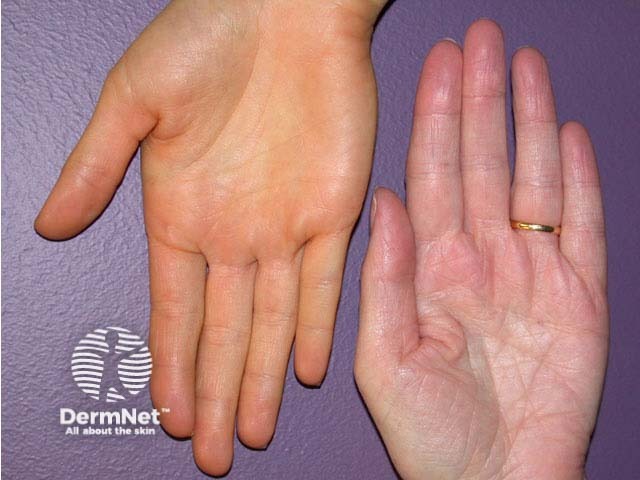Main menu
Common skin conditions

NEWS
Join DermNet PRO
Read more
Quick links
For each of the ten cases, study the image(s) and then answer the questions. You can click on the image to view a larger version if required.
Each case should take approximately five minutes to complete. There is a list of suggested further reading material at the end of the quiz.
When you finish the quiz, you can download a certificate.

What condition is this?
The palm on the left is orange-coloured (xanthochromia). In this case it is due to carotenaemia. The abnormal colour is most easily observed in those with fair skin, particularly where the stratum corneum is thickened on the palms and soles or where there is excessive subcutaneous fat.
The differential diagnosis includes lycopenaemia (from excessive ingestion of tomatoes), riboflavinaemia and drug-induced xanthochromia (e.g. quinacrine). It is distinguished from jaundice because the sclerae are unaffected (bilirubin concentrates in elastic tissue).
What are possible causes?
Carotenaemia is most often due to excessive ingestion of yellow or orange coloured vegetables, most often carrots or pumpkin. Many other foods also contain carotene including asparagus, broccoli, cucumbers, lettuce, spinach, squash, sweet potatoes, tomatoes, yams, corn, apples, oranges, peaches, prunes, egg yolks, milk and butter. Absorption of beta carotene is enhanced by a fatty meal and by mashing the vegetables, hence carotenaemia is relatively common in infants.
Hypothyroidism, diabetes mellitus, hepatic diseases and renal diseases reduce the conversion of beta carotene to vitamin A and hence may be associated with carotenemia. It may be aggravated by hyperlipidaemia, which is thought to contribute to carotenaemia in anorexia nervosa. Metabolic carotenemia without a history of excessive carotene intake may be due to a genetic defect in the metabolism of carotenoids.
If clinically indicated, carotenaemia can be verified by a high serum beta carotene level, a normal or slightly elevated vitamin A level, and normal liver function test results.
What treatment is required?
No specific treatment is required as carotenaemia is harmless. The serum beta carotene level can be increased 3-4 times the normal value and still be associated with a normal or only slightly elevated vitamin A level. A low carotene diet leads to progressive disappearance of the yellow skin discoloration over several months.